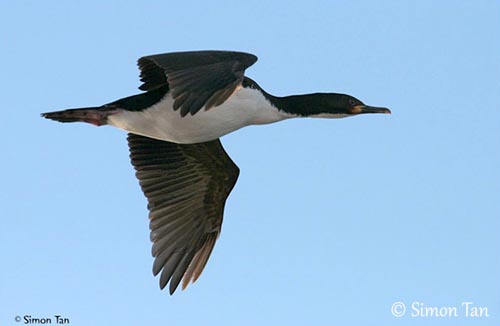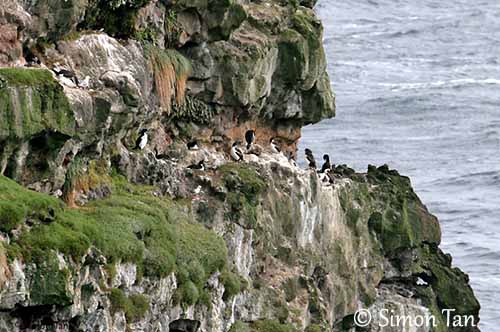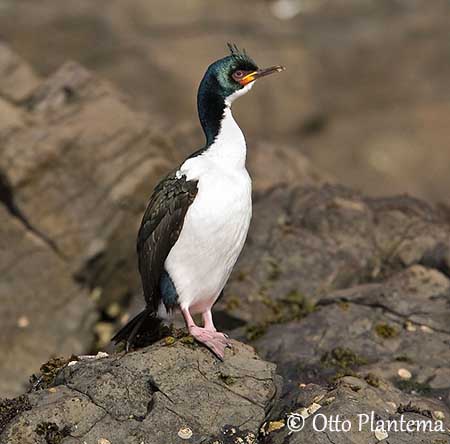
Fr: Cormoran des Auckland
Ang: Auckland (Island) Shag
Maori: Koa
Esp: Cormorán de las Auckland
Ita: Cormorano delle Auckland
Nd: Aucklandaalscholver
Sd: Aucklandskarv
Photographers:
Otto Plantema
Trips around the world
Simon Tan
PBase Bird galleries
Text by Nicole Bouglouan
Sources:
HANDBOOK OF THE BIRDS OF THE WORLD vol 1 by Josep del Hoyo-Andrew Elliot-Jordi Sargatal - Lynx Edicions - ISBN: 8487334105
BirdLife International (BirdLife International)
New Zealand bird status between 2008 and 2012
Auckland (Islands) Shag
Leucocarbo colensoi
Suliformes Order – Phalacrocoracidae Family
INTRODUCTION:
The Auckland Shag is endemic to New Zealand region. It is part of the pink-footed shag species. It is restricted to Auckland Islands where it frequents harbours, inlets and bays. This species is listed as Vulnerable.
DESCRIPTION OF THE BIRD:
Biometrics:
Length: 63 cm
Wingspan: 105 cm
Weight: 2000 g
The adult in breeding plumage is black-and-white. Head and neck show green or blue sheen in sunlight, whereas rest of upperparts are glossy black, with brownish to bronzy-green upperwing. We can see sometimes a white patch on scapulars, and the male may have a central white dorsal patch. However, there is usually a white bar on the median wing-coverts. The tail is dull blackish. The thighs are black with green sheen.
The underparts are white from chin to undertail-coverts. The underwing is mostly blackish.

On the head, there is a fairly tall, recurved, black crest, and sometimes some scattered hair-like white filoplumes. The facial skin is red. The eyering is mostly pinkish-red. The throat pouch is red-orange to purple.
Unlike the three northernmost pink-footed shags, the Auckland Shag lacks the caruncles but it may show orange-yellow rough skin at bill base and along the gape. The black colour of the neck sides may sometimes meet on the foreneck.
The bill is blackish-grey with dark ridge and brown to pale pinkish hooked tip. The eyes are brown. Legs and webbed feet are pale pink with some pale grey wash.
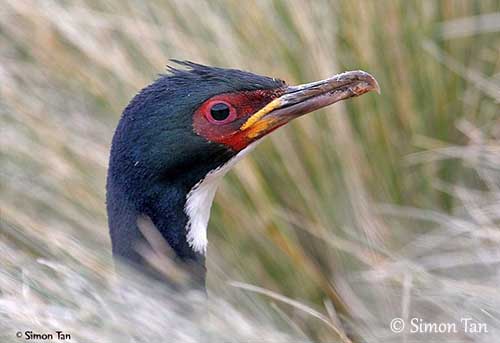
In non-breeding plumage, the adult is duller. It lacks the white filoplumes and the crest is reduced or absent. The eyes are mostly greenish-grey. The face is much duller.
Both sexes have similar plumage, but the male is slightly larger than the female.
The juvenile is dusky grey-brown above and white below. Several wing-coverts are edged pale brown. The eyes are brownish-grey with duller eyering and facial skin.
While changing, the juvenile plumage can appear spotted with the combination of brown feathers and blackish-brown new feathers, whereas white feathers appear on foreneck.
RANGE:
The Auckland Shag occurs in Auckland Islands, South of New Zealand.
HABITAT:
The Auckland Shag frequents sheltered harbours, inlets and bays, and forages equally at sea or in coastal waters.
It breeds and roosts on cliff tops, rocky ledges and hollows, but also on flat ground with tussock grass, or under overhanging rock or trees for protection.
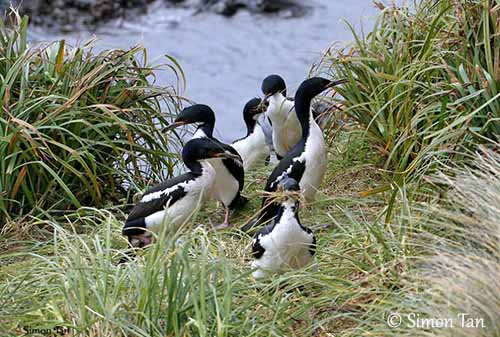
CALLS AND SONGS: SOUNDS BY XENO-CANTO
The Auckland Shag male produces barks and ticking sounds during the courtship displays. The female utters purrs and soft sounds.
The advertising calls by male are barking “borr” or “orr-orrgh”. During the threat displays, it utters “erh-erh-erh” notes. When regurgitating pellets, it produces rapid “gok-gok-gok”.
BEHAVIOUR IN THE WILD:
The Auckland Shag feeds on marine preys such as small fish, squid, marine snails and sea urchins. Most items are taken from the sea-bed. The indigestible parts of preys are regurgitated as pellets, usually one per day.
The preys are caught by pursuit-diving. The bird dives from the surface and swims underwater while pursuing the prey. They may form large feeding groups sometimes.
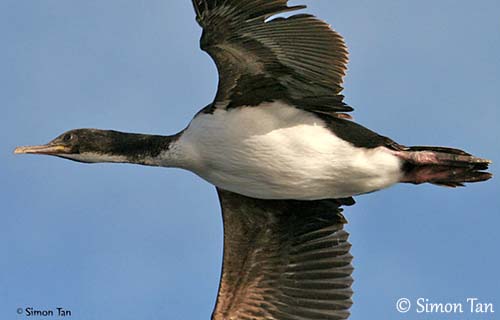
During the breeding season, the male performs elaborate courtship displays such as “gargling” (it throws the head back until the nape touches the rump), “gaping” to expose the bright colours of this area, “bowing” and “penguin-walking”, and several other body postures usually accompanied by calls and barking sounds.
These postures enhance the bright-coloured head pattern and the glossy plumage.
Greeting displays between mates involve back and forth movements of their wide-open bills in front of the vibrating breast.
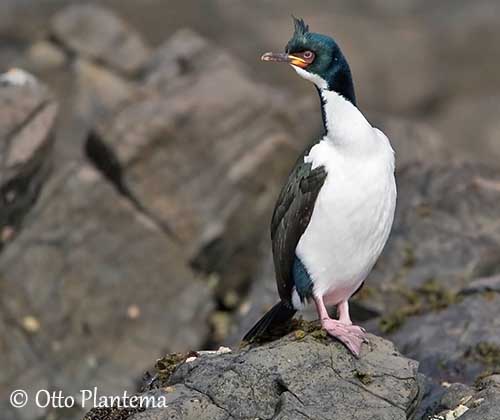
Like numerous cormorant species, the Auckland Shag nests in colonies with nests at least 75 centimetres apart. They are monogamous.
This species is sedentary in Auckland Islands.
The Auckland Shag flies low over the water while searching for preys. It lands on the water, and takes off by running over the surface while flapping the wings strongly.
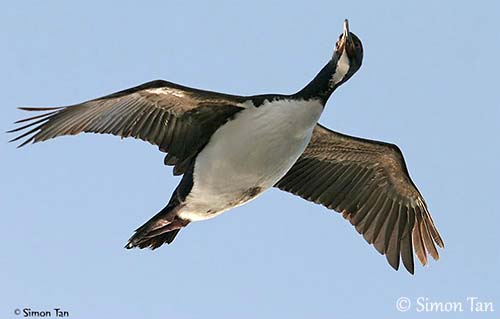
REPRODUCTION OF THIS SPECIES:
The breeding season takes place between November and February.
The colonies are established at cliff tops, on rock ledges and hollows protected by overhanging vegetation or rocks. The colonies are monospecific.
The nest is a flattened bowl made with grass, seaweeds, twigs, guano and debris.
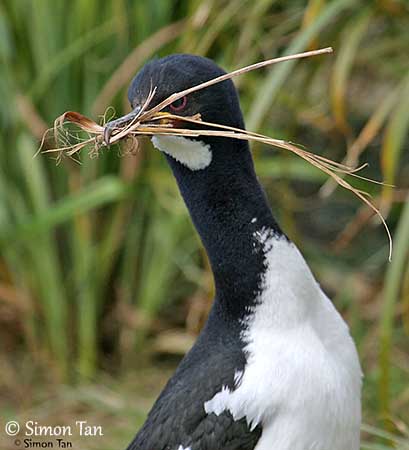
PROTECTION / THREATS / STATUS:
The Auckland Shag is restricted to Auckland Islands. The nests can be destroyed by high tides and storm waves.
The elimination of numerous mammal predator species has involved more stable numbers, but feral pigs destroy any colony they can reach on Auckland Island. Eggs and chicks are killed by the Brown Skua and the Kelp Gull.
The Auckland Shag is currently classified as Vulnerable. The population is estimated at 3,000 mature individuals, involving about 4,500 individuals in total.
